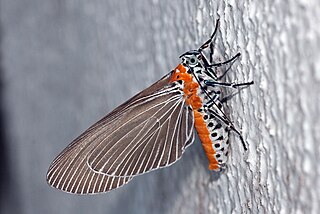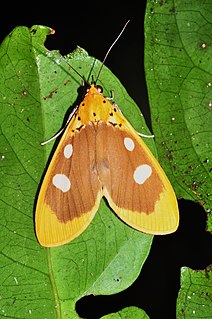
Psilogramma menephron, the privet hawk moth or large brown hawkmoth, is a member of the family Sphingidae. It was described by Pieter Cramer in 1780. It is usually found in Sri Lanka, India, Nepal, central and southern China, Thailand, Vietnam, Indonesia and the Philippines. Psilogramma casuarinae from eastern Australia was long treated as a synonym but is now thought to be a distinct species. The introduced population on Hawaii was first thought to be P. menephron, but is Psilogramma increta.

Oxytenis modestia, the Costa Rica leaf moth, dead-leaf moth, or tropical American silkworm moth, is a species of moth in the family Saturniidae. It was first described by Pieter Cramer in 1780. It occurs from Guatemala to northern South America.

Daphnis hypothous, the jade hawkmoth, is a moth of the family Sphingidae described by Pieter Cramer in 1780. It is known from Sri Lanka, southern and northern India, Nepal, Myanmar, southern China, Taiwan, Thailand, Malaysia, and Indonesia. It is a rare vagrant to the Western Palaearctic realm. During the last hundred years a number have been discovered within the Middle East and one was even found in Scotland late in the 20th century but this was probably imported as a pupa with cargo.

Phigalia titea, the spiny looper or half-wing moth, is a species of moth in the family Geometridae. The species was first described by Pieter Cramer in 1780. The average wingspan is about 34 mm.

Euplocia is a monotypic moth genus in the family Erebidae erected by Jacob Hübner in 1819. Its only species, Euplocia membliaria, was first described by Pieter Cramer in 1780. It is found from the northeastern Himalayas to Sundaland, the Philippines, Sulawesi and the Lesser Sundas.

Gonodonta is a genus of moths in the family Erebidae. The genus was erected by Jacob Hübner in 1818.

Syllectra is a genus of moths in the family Erebidae. The genus was erected by Jacob Hübner in 1819.

Catocala ilia, the Ilia underwing, beloved underwing or wife underwing, is a moth of the family Erebidae. The species was first described by Pieter Cramer in 1776. It can be found in the eastern part of the United States as well as southern Canada. Subspecies Catocala ilia zoe can be found in California and Arizona.

Hulodes caranea is a species of moth of the family Erebidae first described by Pieter Cramer in 1780. It is found from India, Sri Lanka, Myanmar, Java, Hong Kong to Queensland and New Guinea, it is also found on the Marianas and Carolines.

Sphinx gordius, the apple sphinx, is a moth of the family Sphingidae. The species was first described by Pieter Cramer in 1780.

Catocala grynea, the woody underwing, is a moth of the family Erebidae. The species was first described by Pieter Cramer in 1780. It is found in North America from Ontario and Quebec through Maine and Connecticut, south to Florida, west to Texas and north through Iowa to Wisconsin and Minnesota.

Caenurgina erechtea, the forage looper or common grass moth, is a moth of the family Erebidae. The species was first described by Pieter Cramer in 1780. It is found from coast to coast in the United States and adjacent parts of Canada. It is not found in Newfoundland, New Brunswick, Prince Edward Island, Yukon, or the Northwest Territories. The wingspan is 30–42 mm. Adults are on wing from March to November depending on the location.

Asota javana is a moth of the family Erebidae first described by Pieter Cramer in 1780. It is found in Sundaland, the Philippines, Sulawesi and on Sula Island.
Gonodonta nutrix, the citrus fruitpiercer, is a moth of the family Erebidae. The species was first described by Pieter Cramer in 1780 It is found from in Saint Lucia, Cuba, Jamaica, Florida and from Mexico to Paraguay.

Platyja umminia is a species of moth of the family Noctuidae first described by Pieter Cramer in 1780. It is found from the Indo-Australian tropics of China, Japan, India, Sri Lanka, Myanmar to New Guinea and Queensland. It is also present on Guam. Adults have been recorded piercing fruit in Thailand and Guam.

Ametris nitocris, the seagrape spanworm moth, is a moth of the family Geometridae. The species was first described by Pieter Cramer in 1780. It is found from the southern United States through Central America to South America. It is also found on the Antilles.

Lacera alope, the toothed drab, is a moth of the family Erebidae. The species was first described by Pieter Cramer in 1780. It is found in Africa, where it is known from southern and eastern Africa, including several islands of the Indian Ocean, Saudi Arabia, and southern Asia from India, Sri Lanka to China.

Idalus vitrea is a moth of the family Erebidae. It was described by Pieter Cramer in 1780. It is found in Mexico, Guatemala, Honduras, Costa Rica, Panama, Paraguay, Peru, French Guiana, Bolivia, Brazil, and Venezuela.
Zatrephes nitida is a moth in the family Erebidae. It was described by Pieter Cramer in 1780. It is found in French Guiana and Suriname.

















